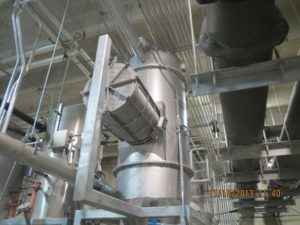Venting
Explosion venting offers a passive and economical means of explosion mitigation. The rupture panel allows for the dangerous level of pressure generated from a dust deflagration to safely vent from the vessel being protected. The panel is precisely designed to burst at a designated predetermined pressure to maintain the structural integrity of the protected equipment by reducing pressure to a tolerable level.
Quench Tube
 Much like explosion venting is a passive solution to mitigate a dust deflagration, a quench tube with allow the hot gases and burning material to safely escape the vessel. However, unlike explosion vents that simply relieve the pressure to atmosphere, the quench tube has a built-in quenching chamber that traps the dust emitted from the deflagration and absorbs the heat from the flame and burning gases. The stainless steel mesh that comprises this chamber then acts as a heatsink to quench the temperature and break the chain reaction of the deflagation, effectively interrupting the explosion in midstream.
Much like explosion venting is a passive solution to mitigate a dust deflagration, a quench tube with allow the hot gases and burning material to safely escape the vessel. However, unlike explosion vents that simply relieve the pressure to atmosphere, the quench tube has a built-in quenching chamber that traps the dust emitted from the deflagration and absorbs the heat from the flame and burning gases. The stainless steel mesh that comprises this chamber then acts as a heatsink to quench the temperature and break the chain reaction of the deflagation, effectively interrupting the explosion in midstream.
Suppression Systems
Explosion suppression systems are an active chemical suppression system for dust explosion mitigation. The principle of operation for a suppression system is detecting the pressure rise during the initial stage of an explosion, followed by fast injection and homogeneous distribution of an extinguishing agent into the protected vessel. The chemical suppression system consists of a controller, pressure or optical detector and a high rate discharge bottle(s).
Mechanical Isolation System
Mechanical isolation is designed to prevent explosion propagation from one vessel to another through the interconnecting piping. It can also be used to prevent hot particles, glowing embers or flames from reaching a vessel and igniting a deflagration or a fire. The isolation valve is normally open during operation. Upon receiving a signal from either a pressure responder, explosion panel or optic sensor, the controller will respond by sending a signal to the valve. The valve will close in milliseconds to isolate the system.
Flap Valve Isolation
During normal operating conditions the flap valve is mechanically retained in the open position providing for a low operating pressure drop. During an upset condition, the regular flow is interrupted and a flux of pressure coming from the opposite direction causes the flap valve to slam and lock shut, effectively preventing the dust deflagration from propagating to interconnected equipment.
High Energy Heat Detection
All fires and dust explosions have an ignition sequence. An effective means of protection is to neutralize these small amounts of energy before they manage to ignite fine dust particles. A high energy heat detection system not only detects sparks, but also hot bodies with temperatures as low as 130° C. Conventional detectors available in the market are detecting light from a spark and are therefore incapable of detecting hot bodies with temperatures below 700° C. The seven control zone detector must detect the heat particle in three zones before triggering a response. The responses can be water quenching, and inert process gas or a mechanical diversion.